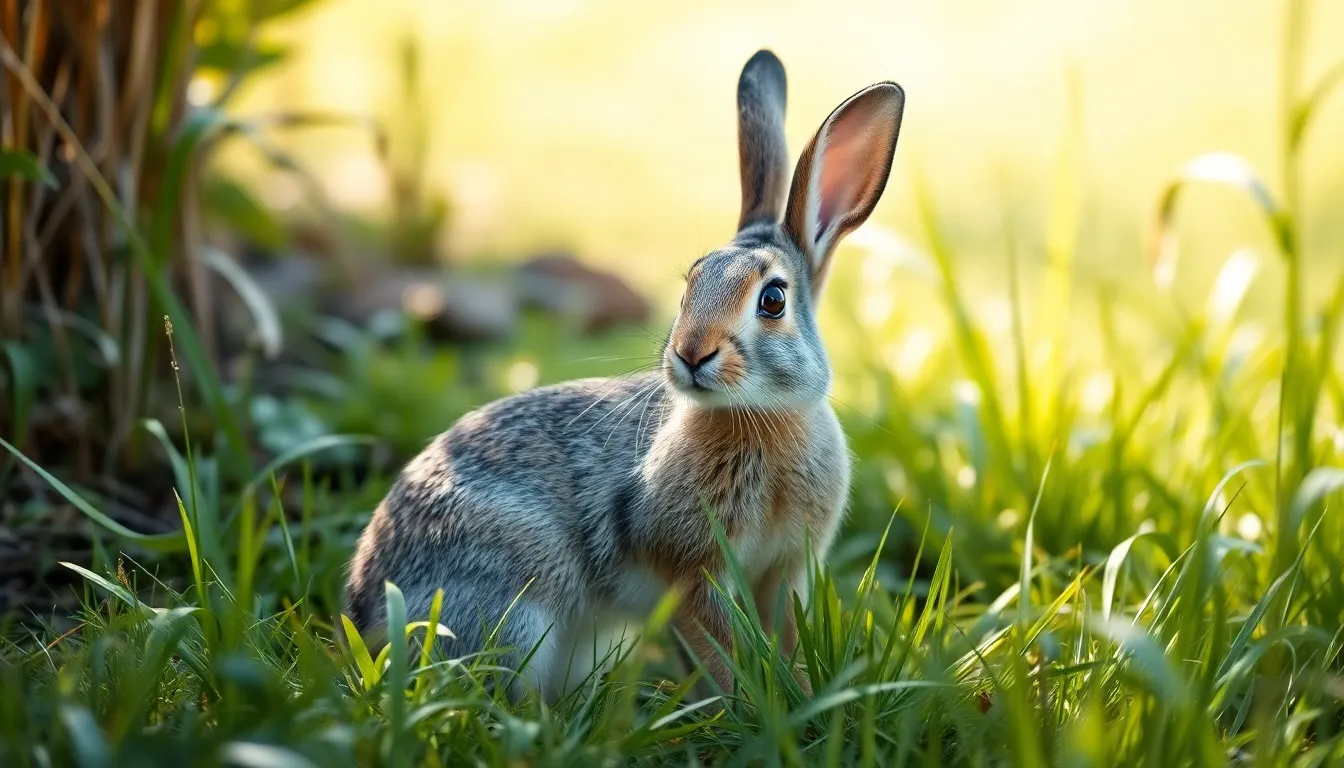When it comes to the animal kingdom, misconceptions abound. One of the most amusing myths is the idea that jack rabbits lay eggs. Picture this: fluffy ears, twitching noses, and a nest of eggs hatching in the spring sun. Sounds cute, right? But let’s hop into reality.
Table of Contents
ToggleUnderstanding Jack Rabbits
Jack rabbits, despite their name, are not true rabbits. They belong to the Lepus genus, characterized by their long ears and strong hind legs, setting them apart in the animal kingdom.
Species Overview
Jack rabbits exist in several species, including the Black-tailed Jack Rabbit, the Desert Jack Rabbit, and the Antelope Jack Rabbit. These species display a range of physical traits, such as varying fur colors and sizes. Black-tailed Jack Rabbits, for example, prominently feature black-tipped ears and tails. Each species shows unique adaptations to its environment, enhancing its survival.
Habitat and Behavior
Jack rabbits thrive in diverse habitats, including grasslands, deserts, and scrublands. They prefer open areas that provide ample space for running. During the day, these animals often rest in shallow depressions or under shrubs to avoid predators. Jack rabbits display impressive agility and speed, reaching up to 40 miles per hour when escaping threats. Socially, they exhibit solitary behaviors, coming together only for mating purposes. Their diet mainly consists of grasses, leaves, and shrubs, allowing them to adapt well to their surroundings.
Reproductive Habits of Jack Rabbits

Jack rabbits exhibit unique reproductive behaviors tailored to their environments. Understanding these habits reveals how they thrive in various habitats.
Mating Season
Mating season for jack rabbits typically occurs from January to September. During this period, males actively compete for the attention of females through displays of strength. Females may mate with multiple males, indicating their preference for genetic diversity. As dusk approaches, increased activity signals courtship rituals among these animals. Males chase females, showcasing their agility and speed. Territorial disputes sometimes arise, reflecting the competitive nature of these creatures.
Gestation Period
Gestation for jack rabbits lasts about 28 to 32 days. After this period, a female can give birth to a litter of up to six young. Young jack rabbits, or leverets, are born fully furred and can see shortly after birth. This immediate independence helps them evade predators. Females often nurse their young in secluded nests during the day, returning only occasionally. Post-nursing, the leverets begin foraging for food to further their development.
Do Jack Rabbits Lay Eggs?
Jack rabbits do not lay eggs. Instead, they give birth to live young, a behavior typical of mammals.
Scientific Explanation
Jack rabbits belong to the Lepus genus and are classified as hares. Unlike birds, these creatures undergo a reproductive process where fertilization occurs internally. A gestation period of about 28 to 32 days precedes the birth of leverets. Females typically produce litters numbering up to six young. Leverets arrive fully furred and possess the ability to see shortly after birth. These adaptations enhance their survival chances in the wild.
Common Misconceptions
Some people mistakenly believe jack rabbits lay eggs due to their name. Given the playful nature of the term “rabbit,” one might envision them hatching eggs like birds. Cultural references often perpetuate this misconception. Hares and rabbits differ significantly in reproductive methods. Educating the public on these distinctions helps clarify the facts surrounding jack rabbits.
Comparison with Other Species
Understanding the differences between jack rabbits and other species clarifies misconceptions about their reproductive habits.
Rabbits vs. Hares
Rabbits and hares belong to separate genera within the Leporidae family. Unlike rabbits, hares tend to be larger and possess longer ears and legs. Their young, known as leverets, are born fully furred and develop faster than bunny kits, which are born hairless and vulnerable. Social behaviors differentiate the two as well; rabbits often live in social groups, while hares maintain solitary lifestyles. Despite their similarities, the most notable difference lies in their reproductive strategies, highlighting that only mammals give birth to live young, such as jack rabbits.
Egg-Laying Animals
Distinctly different from mammals, egg-laying animals include birds, reptiles, amphibians, and some fish. Birds, such as chickens and sparrows, lay eggs with hard shells for protection. Reptiles like turtles and snakes lay leathery eggs, while amphibians, including frogs, typically lay gelatinous clusters in water. These species illustrate diverse reproductive strategies that adapt to their environments. Recognizing that jack rabbits give birth to live young underscores the unique classification of mammals in contrast to these egg-laying species.
Jack rabbits are fascinating creatures that defy the myth of egg-laying. As mammals they give birth to live young which is a key characteristic of their classification. Their unique adaptations and behaviors contribute to their survival in various habitats.
Understanding the distinctions between jack rabbits and true rabbits enhances appreciation for these animals. By debunking misconceptions the article highlights the importance of accurate information in the animal kingdom. Jack rabbits continue to intrigue with their remarkable agility and solitary nature making them a captivating subject for wildlife enthusiasts.




